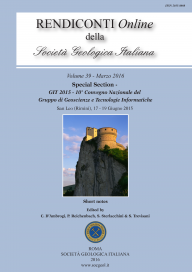
Preliminary geochemical characterization of the thermal waters of the Grotta delle Ninfe near Cerchiara di Calabria (South Italy)
Giovanni Vespasiano (a), Carmine Apollaro (a), Francesco Muto (b), Rosanna De Rosa (a),
Elissavet Dotsika (c) & Luigi Marini (d)
(a) Department of Biology, Ecology and Earth Sciences (DIBEST), University of Calabria, via Ponte Bucci 4, cubo 15B, I-87036 Arcavacata di Rende (CS), Italy. E-mail: giovanni.vespasiano@unical.it
(b) Department of Engineering for Environment, Territory and Chemical Engineering, University of Calabria, via Ponte Bucci 4, cubo 45B, I-87036 Arcavacata di Rende (CS), Italy.
(c) National Center for Scientific Research ''Demokritos'', 15310 Aghia Paraskevi, Athens, Greece.
(d) Luigi Marini Individual Company, Via A. Fratti 253, I-55049 Viareggio (LU), Italy.
Volume: 39/2016
Pages: 130-133
Abstract
A preliminary geochemical characterization of Cerchiara thermal waters was carried out. Waters discharging at the Cerchiara springs come from a deep circuit, which is chiefly hosted in the limestones, dolomitic limestones and evaporites of the Pollino Unit. Triangular plots of major dissolved cations and anions show that the Cerchiara thermal waters have a mixed Na(Ca)-Cl(HCO3-SO4) composition deriving from extended interaction with carbonate-evaporite rocks. Dissolved sulfate has an Upper Triassic derivation as indicated by sulfur isotopes provided that the effects of bacterial sulfate reduction are properly taken into account. Meteoric waters, infiltrating in the Pollino massif at elevations close to 1800 m asl, recharge the deep aquifer deepening along one or more fault systems, as suggested by local structural geology. They acquire heat from reservoir rocks through conductive transfer during their prolonged circulation into the deep aquifer at temperatures close to 40°C and PCO2 of ~2.5 bar. The thermal deep aquifer acts as a sort of well-mixed reservoir, whose fluids are completely mixed with the fluids entering it. The water leaving the deep reservoir discharges at the surface at 30 °C after a relatively fast upflow and limited cooling. The upward part of the hydrogeological circuit is controlled by local low and high-angle fault systems as well as by the tectonic window of Cerchiara di Calabria, where the Cerchiara Formation crops out.
Keywords
Get Full Text